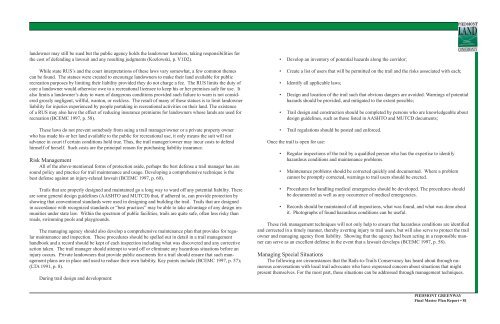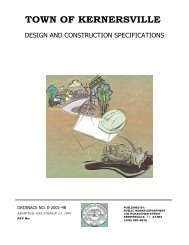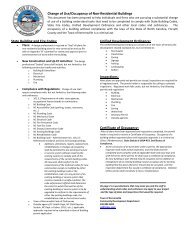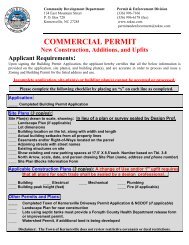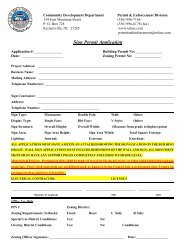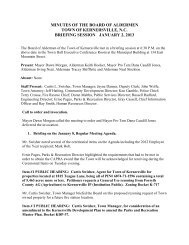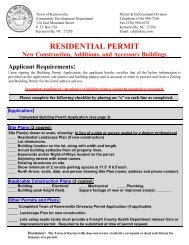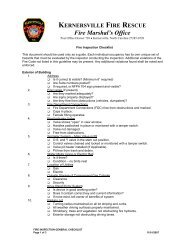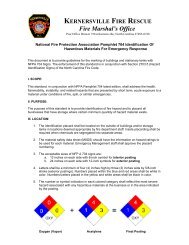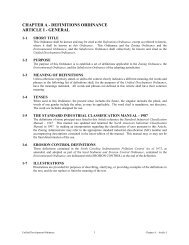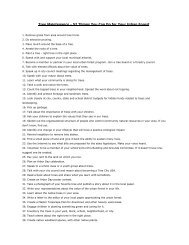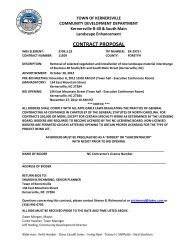Piedmont Greenway Master Plan - Town of Kernersville
Piedmont Greenway Master Plan - Town of Kernersville
Piedmont Greenway Master Plan - Town of Kernersville
- No tags were found...
Create successful ePaper yourself
Turn your PDF publications into a flip-book with our unique Google optimized e-Paper software.
landowner may still be sued but the public agency holds the landowner harmless, taking responsibilities for<br />
the cost <strong>of</strong> defending a lawsuit and any resulting judgments (Kozlowski, p. V1D2).<br />
While state RUS’s and the court interpretations <strong>of</strong> these laws vary somewhat, a few common themes<br />
can be found. The statues were created to encourage landowners to make their land available for public<br />
recreation purposes by limiting their liability provided they do not charge a fee. The RUS limits the duty <strong>of</strong><br />
care a landowner would otherwise owe to a recreational licensee to keep his or her premises safe for use. It<br />
also limits a landowner’s duty to warn <strong>of</strong> dangerous conditions provided such failure to warn is not considered<br />
grossly negligent, willful, wanton, or reckless. The result <strong>of</strong> many <strong>of</strong> these statues is to limit landowner<br />
liability for injuries experienced by people partaking in recreational activities on their land. The existence<br />
<strong>of</strong> a RUS may also have the effect <strong>of</strong> reducing insurance premiums for landowners whose lands are used for<br />
recreation (BCEMC 1997, p. 58).<br />
These laws do not prevent somebody from suing a trail manager/owner or a private property owner<br />
who has made his or her land available to the public for recreational use, it only means the suit will not<br />
advance in court if certain conditions hold true. Thus, the trail manager/owner may incur costs to defend<br />
himself <strong>of</strong> herself. Such costs are the principal reason for purchasing liability insurance.<br />
Risk Management<br />
All <strong>of</strong> the above-mentioned forms <strong>of</strong> protection aside, perhaps the best defense a trail manager has are<br />
sound policy and practice for trail maintenance and usage. Developing a comprehensive technique is the<br />
best defense against an injury-related lawsuit (BCEMC 1997, p. 60).<br />
Trails that are properly designed and maintained go a long way to ward <strong>of</strong>f any potential liability. There<br />
are some general design guidelines (AASHTO and MUTCD) that, if adhered to, can provide protection by<br />
showing that conventional standards were used in designing and building the trail. Trails that are designed<br />
in accordance with recognized standards or “best practices” may be able to take advantage <strong>of</strong> any design immunities<br />
under state law. Within the spectrum <strong>of</strong> public facilities, trails are quite safe, <strong>of</strong>ten less risky than<br />
roads, swimming pools and playgrounds.<br />
The managing agency should also develop a comprehensive maintenance plan that provides for regular<br />
maintenance and inspection. These procedures should be spelled out in detail in a trail management<br />
handbook and a record should be kept <strong>of</strong> each inspection including what was discovered and any corrective<br />
action taken. The trail manager should attempt to ward <strong>of</strong>f or eliminate any hazardous situations before an<br />
injury occurs. Private landowners that provide public easements for a trail should ensure that such management<br />
plans are in place and used to reduce their own liability. Key points include (BCEMC 1997, p. 57);<br />
(LTA 1991, p. 8).<br />
During trail design and development:<br />
• Develop an inventory <strong>of</strong> potential hazards along the corridor;<br />
• Create a list <strong>of</strong> users that will be permitted on the trail and the risks associated with each;<br />
• Identify all applicable laws;<br />
• Design and location <strong>of</strong> the trail such that obvious dangers are avoided. Warnings <strong>of</strong> potential<br />
hazards should be provided, and mitigated to the extent possible;<br />
• Trail design and construction should be completed by persons who are knowledgeable about<br />
design guidelines, such as those listed in AASHTO and MUTCD documents;<br />
• Trail regulations should be posted and enforced.<br />
Once the trail is open for use:<br />
• Regular inspections <strong>of</strong> the trail by a qualified person who has the expertise to identify<br />
hazardous conditions and maintenance problems.<br />
• Maintenance problems should be corrected quickly and documented. Where a problem<br />
cannot be promptly corrected, warnings to trail users should be erected.<br />
• Procedures for handling medical emergencies should be developed. The procedures should<br />
be documented as well as any occurrence <strong>of</strong> medical emergencies.<br />
• Records should be maintained <strong>of</strong> all inspections, what was found, and what was done about<br />
it. Photographs <strong>of</strong> found hazardous conditions can be useful.<br />
These risk management techniques will not only help to ensure that hazardous conditions are identified<br />
and corrected in a timely manner, thereby averting injury to trail users, but will also serve to protect the trail<br />
owner and managing agency from liability. Showing that the agency had been acting in a responsible manner<br />
can serve as an excellent defense in the event that a lawsuit develops (BCEMC 1997, p. 58).<br />
Managing Special Situations<br />
The following are circumstances that the Rails-to-Trails Conservancy has heard about through numerous<br />
conversations with local trail advocates who have expressed concern about situations that might<br />
present themselves. For the most part, these situations can be addressed through management techniques.<br />
PIEDMONT GREENWAY<br />
Final <strong>Master</strong> <strong>Plan</strong> Report • 81


